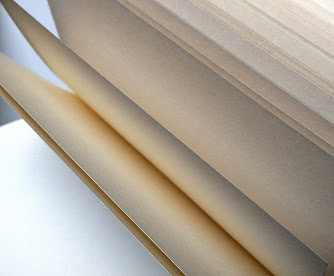The Silmarillion — Clowes Dummy (1977)
%20ISBN%20CUT%20%234%20Adj.jpg) |
In the nineteenth and twentieth centuries, with the advance of mechanical binding, the publisher's binding would become the norm. Dummy books—as we (or I) would think of them today—were prepared (pre-publication) for a range of purposes by (and for) publishers, printers, and binders. Actual materials would be used to show the proposed size/bulk of the final product; this, in turn, would inform dustjacket design, the design of blocking brasses to be used, and so on.[1] Final binding materials—like the type of bookcloth or paper covering for example—could be displayed on-book; other dummy books were made to illustrate layout, showing margins, the positioning of illustrations and maps, etc.[2] Dummy books were an important step in book design.
Dummy books that closely resembled the final appearance of the book, rather than an aspect of pre-publication design, were also still made—like some of those old specimen books—for the primary purpose of generating interest and sales; for the publisher to present to the bookseller, and for the bookseller to display to their customers; the aim, to convince the bookseller to carry a new release and, in turn, to help the bookseller solicit orders from the book-buying public. Timely distribution of dummy copies by the publisher would help encourage pre-publication orders.
Not to be conflated with review copies, proof copies (or similar), this type of dummy book would often only include a part of the text; prelims, opening chapters, etc. With large portions of the text omitted, the remaining pages would be included (blank and unprinted) to replicate the size—and intended number of pages—of the final copy, and also to allow the increasingly important dustjacket to be viewed in situ.[†]
 |
| Unprinted pages |
Although modern dummy books are infrequently encountered today, one would assume they remain—even in an increasingly digital publishing world—an important step in product design where the planned final presentation is still intended to be a physical book. Some alternative names for dummy books—not an exhaustive list, nomenclature is inconsistent—include: dummy edition, salesman's edition, salesman's dummy, salesman's sample, publisher's dummy, printer's dummy, bulking dummy, specimen book, specimen copy.
 |
| Clowes dummy (S.136) |
In 1977, with The Silmarillion, the dummy book we encounter—the only type it would seem—is the aforementioned dummy book ‘made for the publisher to present to the bookseller, and for the bookseller to display to their customers’ type. I refer to this as the Clowes Dummy.
Holford (TOLKIENBOOKS.NET entry) identifies two dummy states of The Silmarillion: ‘1) With the pages printed up to page 32’, and a second printed to p. 35; both printed by WILLIAM CLOWES & SONS, priority of printing not determined. A fully blank dummy copy was listed for sale on TOLKIENLIBRARY.COM (c. 2010) and described as ‘completely filled with blank pages’; however, no later than 2017, the description was amended to include a qualifier stating ‘all the signs are there [that] someone removed the first 32 pages’. Holford's original TOLKIENBOOKS.NET entry (now amended) had used information derived from an earlier EBAY listing for this same book.[3] This third Holford dummy state with no printed content—possibly (hypothetically) preceding both the 32 and 35 page states—is now thought not to exist.
%20CUT.jpg) |
| Dummy copy printed to p. 32 |
In Science Fiction And Fantasy Authors, L. W. Currey—assembling material for his work almost contemporary with the publication of The Silmarillion—describes two GA&U dummy states under ‘export edition’; defined by Currey as printed by WILLIAM CLOWES & SONS, with an unpriced dustjacket. While Currey's ‘dummy B’ appears to match the description for both Holford states—Currey makes no mention of how far the text is printed to—Currey's ‘dummy A’ has features not noted elsewhere.
%20CUT%20%232%20Adj.jpg) |
| Proof copy publisher's imprint |
No dummy copy of The Silmarillion fitting this description has, as far as I'm aware, been seen or noted in collecting circles. One could suggest several explanations for this. It is possible none have survived. It is also possible Currey had something else in front of him, like a bound proof or similar. However, in 1981 a book catalogue offered both Currey dummy states for sale.[5] So, either both Currey and Hime(s) erred, which is possible but feels unlikely; or no copies have survived or have since re-surfaced. I think it only fair to assume the latter.
 |
| GA&U letter to bookseller |
Dummy copies of The Silmarillion are known to have been distributed to booksellers as late as 22 August 1977 (see above letter), but it seems unlikely Clowes Dummy copies weren't distributed before this date to promote sales. WILLIAM CLOWES & SONS is the only known printer/binder of dummy copies; other printers either never produced dummy copies or copies are nonextant.
From the relatively scanty evidence here presented I think it can be suggested—tentatively, since the earlier Currey dummy has not been seen—that at least three Clowes Dummy states exist: Currey ‘dummy A’ and the two described by Holford.
ACKNOWLEDGEMENTS: I would like to thank the owners
of both the page proofs and the GA&U letter for allowing me to share and discuss these images.
![[The] Silmarillion; book-collecting minutiae](https://blogger.googleusercontent.com/img/a/AVvXsEi7NXZeS-e6C3roxz2c7UWFEcUEINpMfgDkihMCeoVgjBGA-K9_wE7HmJ0J5LSIJqNm8fDVUqJ5HOvdvgIHgPctu9xPEx_CjPUqrXJEyd5Q-ftA4tlo6NhRx3V9JZl-IBbGvIvBQVjE9GFyKMqd_JrWwkLEqMMbhG2m3Q3FQuyhnjhlhdpebGxovD9adS1H=s456)
%20ISBN%20CUT%20%232%20Adj.jpg)


.jpeg)
Comments
Post a Comment